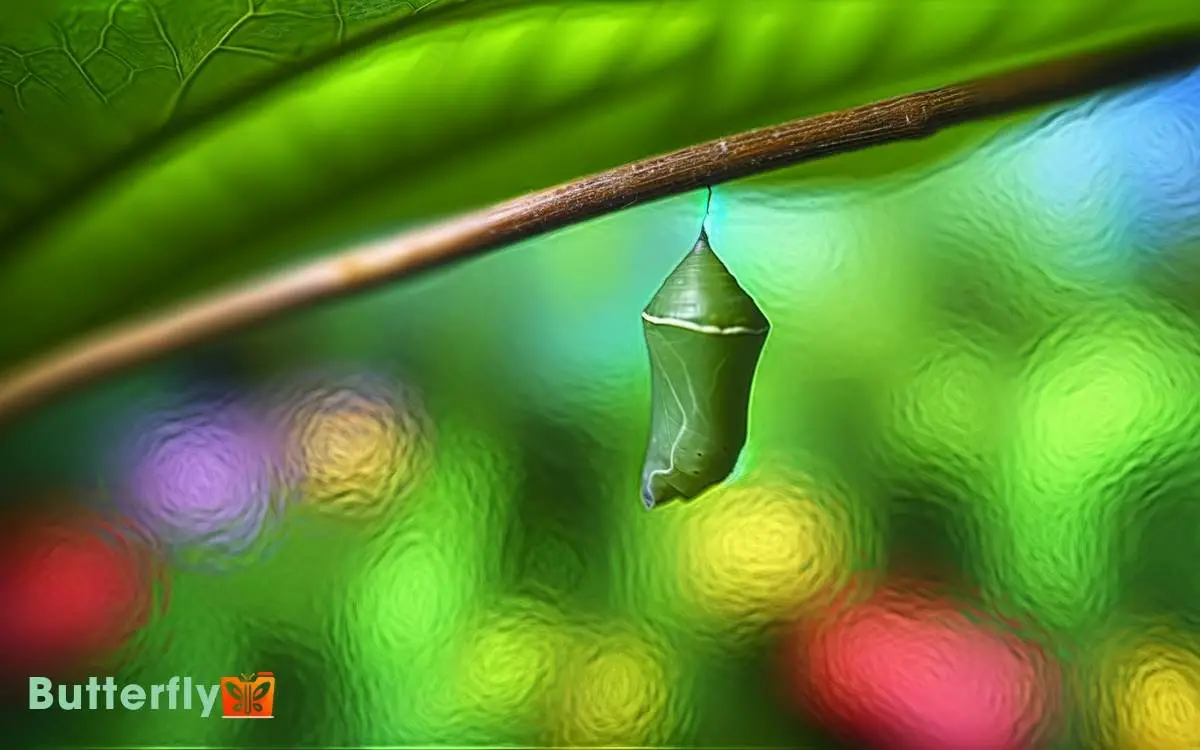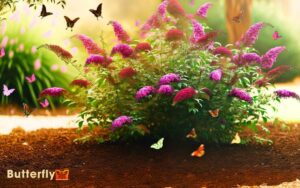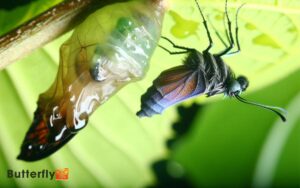How To Hang Chrysalis In Butterfly Habitat? Explore!
To hang a chrysalis in a butterfly habitat, start by using non-toxic, breathable mesh for airflow and secure placement. Sanitize the habitat with a mild bleach solution and make sure it’s thoroughly dry.
Attach natural twigs or wooden dowels using hot glue. Position the chrysalis at an elevation of 4-6 feet, securing it with non-toxic adhesive at its attachment point. Maintain controlled humidity with absorbent paper towels and monitor levels using a hygrometer.
Guarantee indirect sunlight and use fine mesh to prevent predators. Remember, each meticulous step you take enhances the success of the metamorphosis process.

Key Takeaways
Choosing the Right Materials
Selecting appropriate materials for creating a secure and suitable butterfly habitat is essential to guarantee the successful development of chrysalises.
You’ll need non-toxic, breathable mesh for the enclosure to ensure ideal airflow and prevent mold growth. Opt for a fine gauge to keep out pests.
For perching surfaces, choose natural twigs or sterilized wooden dowels, which provide a firm grip for the chrysalises. Attach these securely using hot glue or biodegradable twine.
Include absorbent paper towels at the bottom to maintain humidity levels without waterlogging. For hydration, use a shallow dish with pebbles.
Preparing the Habitat
To prepare the habitat, meticulously sanitize all components to eliminate any potential contaminants that could harm the chrysalises.
Use a mild bleach solution (1 part bleach to 9 parts water) to disinfect the habitat’s surfaces, making sure you cover every nook and cranny. Rinse thoroughly with clean water and allow it to dry completely.
Inspect the habitat for sharp edges or protrusions that could damage the delicate chrysalises.
Utilize a digital hygrometer to monitor humidity levels, aiming for 60-70% humidity to mimic natural conditions. Install a low-wattage, full-spectrum UV light to replicate sunlight, promoting healthy development.
Ensure adequate ventilation by adjusting mesh panels or air holes, fostering an ideal airflow without compromising the microenvironment’s stability.
Identifying Suitable Locations
You must prioritize locations with ideal light conditions, ensuring the chrysalis receives indirect sunlight without overheating.
Position the habitat to minimize exposure to potential predators, taking care to avoid areas frequented by birds or small mammals.
Regularly monitor these factors to maintain a safe and conducive environment for metamorphosis.
Optimal Light Conditions
How can you determine the best light conditions for hanging a chrysalis in a butterfly habitat? Focus on guaranteeing natural light without harsh direct sunlight, which can overheat the chrysalis.
Use these guidelines:
- Light Intensity: Aim for moderate light exposure, around 10,000-20,000 lux, to mimic natural conditions.
- Duration of Exposure: Guarantee the habitat receives 12-14 hours of light daily to support circadian rhythms.
- Light Diffusion: Utilize diffused light sources, such as sheer curtains, to prevent direct sunlight while maintaining adequate illumination.
- Positioning: Place the habitat near a north-facing window for consistent light without the intensity of direct morning or afternoon sun.
Avoiding Predators’ Reach
When identifying suitable locations to hang a chrysalis, make sure the habitat is elevated and secure to minimize the risk of predator access. Position the chrysalis at least 4-6 feet above ground level to deter ground-based predators like rodents.
Utilize fine mesh or netting to create a barrier while ensuring adequate airflow. Avoid placing the chrysalis near dense foliage, which may harbor spiders or ants. Instead, opt for an open yet sheltered spot to shield from direct weather elements.
Inspect the area for any signs of predator activity and consider using natural deterrents like essential oils. By following these guidelines, you’ll create a safer environment, fostering successful metamorphosis and butterfly emergence. Additionally, regularly check the undersides of leaves for pests that may threaten caterpillars and take proactive measures to protect them. Implementing butterfly egg removal methods when necessary can help manage populations of undesirable insects without harming beneficial species. Maintaining a balanced ecosystem will ultimately support the health and survival of butterflies in your garden.
Securing the Chrysalis
To guarantee the chrysalis remains stable and secure, attach it gently but firmly to a designated hanging structure using a small dab of non-toxic adhesive. This meticulous approach ensures the chrysalis maintains its best orientation and isn’t exposed to unnecessary stressors.
Follow these steps:
- Identify the Attachment Point: Locate the cremaster or silk pad at the top of the chrysalis.
- Prepare the Adhesive: Use a non-toxic, quick-drying adhesive to avoid harmful chemical exposure.
- Apply the Adhesive: Place a tiny amount on the attachment point without covering it entirely.
- Position and Hold: Carefully press the chrysalis onto the hanging structure and hold it for a few seconds to ensure a firm bond.
These steps will enhance the likelihood of successful metamorphosis.
Using Pins and Clips
Opting for pins and clips offers an alternative method for securing the chrysalis, guaranteeing stability through mechanical means.
Begin by gently attaching a small pin or clip to the silk pad from which the chrysalis hangs. Make sure the attachment doesn’t damage the delicate structure.
Utilize entomology pins or specialized clips designed for minimal interference. Position the chrysalis vertically, mimicking natural orientation, and secure it to the habitat’s mesh or another stable surface.
This method allows for precise control over placement and ensures that the chrysalis remains undisturbed during metamorphosis.
Regularly inspect the attachment to ensure it remains secure, adjusting as necessary to maintain optimal conditions for the emerging butterfly. This innovative approach enhances observational opportunities.
Ensuring Proper Ventilation
Maintaining proper ventilation in the butterfly habitat is essential to guarantee the best airflow, preventing the buildup of humidity that could jeopardize the chrysalis’s development.
You need to establish an ideal environment with precise methods:
- Mesh Screens: Utilize fine mesh screens on habitat openings to allow airflow while keeping pests out.
- Air Circulators: Install small, quiet fans to promote air movement without causing turbulence that might harm the chrysalides.
- Ventilation Grilles: Integrate adjustable ventilation grilles to control the amount of fresh air entering the habitat.
- Natural Ventilation: Position the habitat near windows or vents that can be opened periodically to refresh the air naturally.
These steps will help create an innovative and controlled environment, fostering healthy chrysalis development.
Monitoring Humidity Levels
Accurate monitoring of humidity levels within the butterfly habitat is essential for the best development of the chrysalis. Use a hygrometer to measure humidity, aiming for a 60-70% range. Too low or high humidity can hinder metamorphosis or cause desiccation.
| Humidity Level | Observations | Actions |
|---|---|---|
| < 50% | Dry, brittle chrysalis | Increase water source |
| 50-60% | Slight dehydration | Add moisture |
| 60-70% | Ideal range | Maintain conditions |
Maintain precise control by adjusting water sources and ventilation. Regularly log humidity readings, and make necessary adjustments promptly.
Innovate by integrating automated systems to ensure the best conditions. You’ll see more robust, healthy butterflies emerge, all thanks to meticulous humidity management.
Preventing Predators
You must establish a secure habitat environment by implementing physical barriers and maintaining structural integrity to prevent intrusions.
Utilize natural predator barriers such as mesh enclosures and companion planting to deter common threats like ants and birds.
Regularly inspect for breaches and reinforce weak points to maintain a protective perimeter.
Secure Habitat Environment
To safeguard the chrysalis from predators, it’s crucial to install fine mesh netting around the butterfly habitat. This creates a barrier that prevents entry of harmful insects and animals.
The netting should have a mesh size smaller than 0.5 mm to guarantee it effectively excludes even the smallest potential predators.
Here’s how you can enhance the security of your habitat:
- Double-layered Netting: Employ two layers of fine mesh for added protection.
- Secure Fastenings: Use robust clips or ties to secure the netting, preventing gaps.
- Regular Inspections: Frequently check the habitat for any breaches or damages.
- Elevated Positioning: Position the habitat above ground to deter ground-dwelling predators.
Natural Predator Barriers
Establishing natural predator barriers within the butterfly habitat involves using physical elements and strategic placements to guarantee potential predators are kept at bay.
First, utilize fine mesh netting around the habitat to prevent small predators like ants and spiders from entering. Positioning the habitat off the ground can also deter ground-based threats such as rodents.
Incorporate plants that naturally repel insects, such as marigolds, within the habitat. Guarantee the structural integrity of the habitat by regularly inspecting for gaps or weak points where predators might infiltrate.
Use reflective materials or decoy predators like plastic owls to create an uninviting environment for birds. By implementing these scientifically-backed strategies, you’ll create a safer, predator-resistant space for your developing chrysalides.
Observing the Transformation
Through careful observation, one can witness the intricate process by which a caterpillar metamorphoses into a butterfly within the protective embrace of its chrysalis. Documenting this transformation requires precision and patience.
Here’s how you can methodically observe each stage:
- Initial Pupation: Watch as the caterpillar forms its chrysalis, a process known as pupation. Note the changes in color and texture.
- Chrysalis Development: Over the next 10-14 days, observe the subtle shifts in the chrysalis, signaling internal changes.
- Pre-Emergence: Just before emergence, the chrysalis becomes translucent, revealing the butterfly’s wings.
- Emergence: Finally, observe the butterfly’s eclosion, as it breaks free, expanding its wings and preparing for flight.
Conclusion
With your chrysalis securely hung, you’re now the guardian of a metamorphic marvel.
Every detail, from choosing materials to monitoring humidity, serves as the keystone in this delicate dance of nature.
As you watch, transformation unfurls like a complex algorithm, precision turning a humble chrysalis into a butterfly.
Stay vigilant against predators and maintain a perfect environment.
You’re not just a spectator; you’re an integral part of this scientific symphony.
Embrace the wonder.






